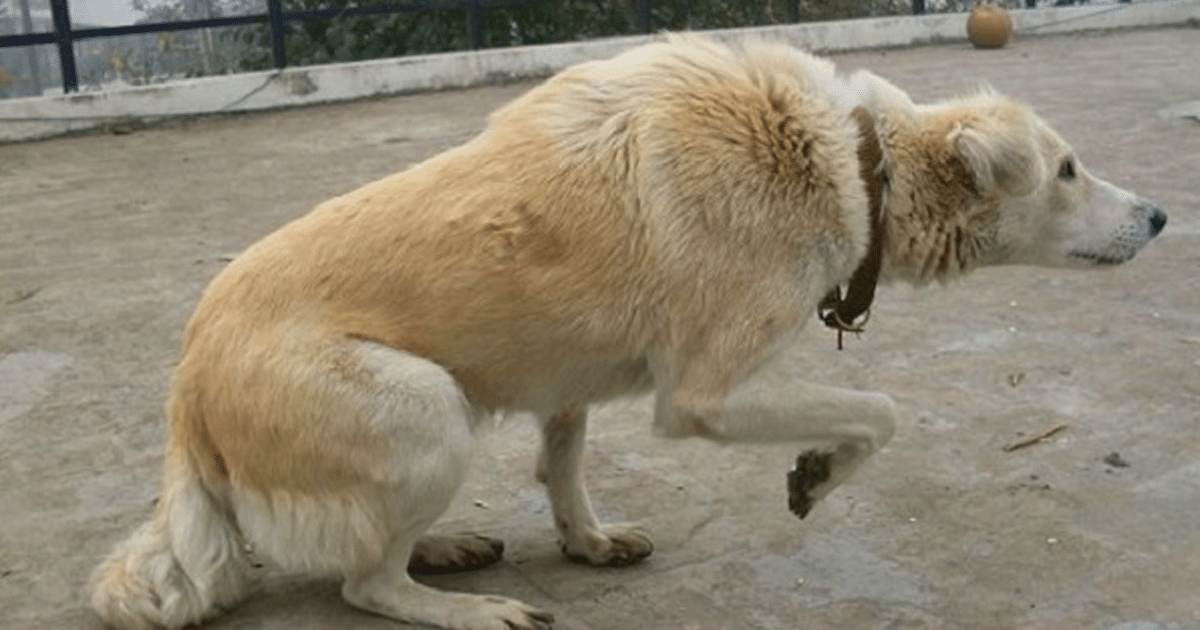
Many pet owners wonder if it’s safe for dogs to consume gum, but the truth is that gum can be extremely dangerous for our canine companions. Gum, especially sugar-free gum that contains xylitol, can pose serious health risks to dogs. Xylitol is a low-calorie sugar substitute that is highly toxic to dogs, even in small quantities.
Key Takeaways:
- Gum, especially sugar-free gum containing xylitol, is dangerous for dogs and should be kept out of their reach.
- Xylitol can cause a sudden drop in blood sugar levels in dogs, leading to symptoms such as vomiting, weakness, seizures, and liver damage.
- If a dog ingests gum or any product containing xylitol, immediate veterinary care should be sought.
- Treatment for xylitol toxicity involves monitoring blood sugar levels and providing supportive care.
- It’s important to dog-proof your home and be cautious of other products that may contain xylitol.
The Dangers of Dogs Eating Gum Containing Xylitol
It’s crucial to understand the dangers associated with dogs ingesting gum, especially those that contain xylitol. Xylitol is a sugar substitute commonly found in sugar-free gum and other products. While it is safe for humans, it can be highly toxic to dogs.
Xylitol causes a rapid release of insulin in dogs, leading to a sudden drop in blood sugar levels. This condition, known as hypoglycemia, can be life-threatening if left untreated. Symptoms of xylitol toxicity in dogs include vomiting, weakness, seizures, and even liver damage.
This image provides a visual representation of the dangers of gum containing xylitol for dogs:
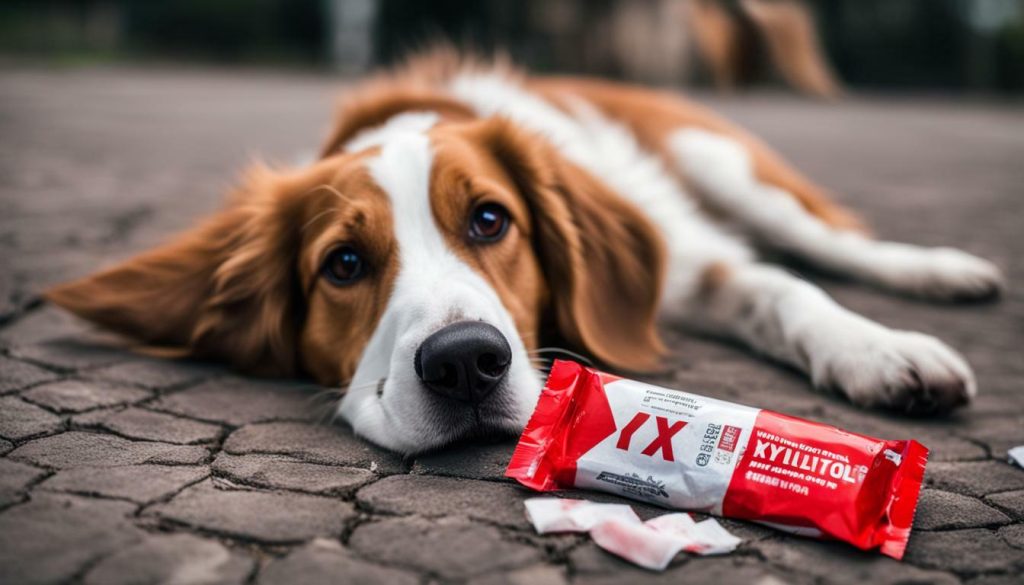
As you can see, it only takes a small amount of gum containing xylitol to potentially harm a dog. That’s why it’s essential to keep all gum and xylitol-containing products out of reach of pets. If you suspect that your dog has ingested gum or any product containing xylitol, it is crucial to seek immediate veterinary care. There is no antidote for xylitol toxicity, so treatment focuses on monitoring the dog’s blood sugar levels and providing supportive care.
| Symptoms of Xylitol Toxicity in Dogs |
|---|
| Vomiting |
| Weakness |
| Seizures |
| Elevated heart rate |
| Liver damage |
To prevent xylitol toxicity in dogs, it’s important to dog-proof your home and be cautious of other products that may contain this ingredient. This includes certain dental products, medications, and personal care items. Always read labels carefully and consult with your veterinarian if you are unsure if a product is safe for your dog.
Safe Alternatives to Gum for Dogs
- Dog-specific toothpaste (avoid using human toothpaste)
- Dental treats designed for dogs
These alternatives can help promote your dog’s dental health without the risk of xylitol toxicity.
Symptoms of Xylitol Toxicity in Dogs
Dogs who consume gum with xylitol can exhibit various symptoms of toxicity that indicate a serious health concern. Xylitol is rapidly absorbed into a dog’s bloodstream, causing a sudden release of insulin from the pancreas. This leads to a sharp drop in blood sugar levels, a condition known as hypoglycemia. Some common symptoms of xylitol toxicity in dogs include:
- Vomiting
- Lethargy
- Weakness
- Loss of coordination
- Tremors or seizures
- Collapsed or unresponsive state
If you suspect that your dog has ingested gum containing xylitol, it is crucial to seek immediate veterinary care. Time is of the essence in treating xylitol toxicity, as severe cases can be life-threatening. Your veterinarian will perform a thorough examination and may conduct blood tests to assess your dog’s blood sugar levels and liver function.
Once diagnosed, treatment typically involves inducing vomiting to remove any remaining gum from the dog’s stomach. In some cases, activated charcoal may be administered to absorb the toxins. Monitoring your dog’s blood sugar levels and providing supportive care, such as intravenous fluids and glucose supplementation, will be essential in managing the toxicity.
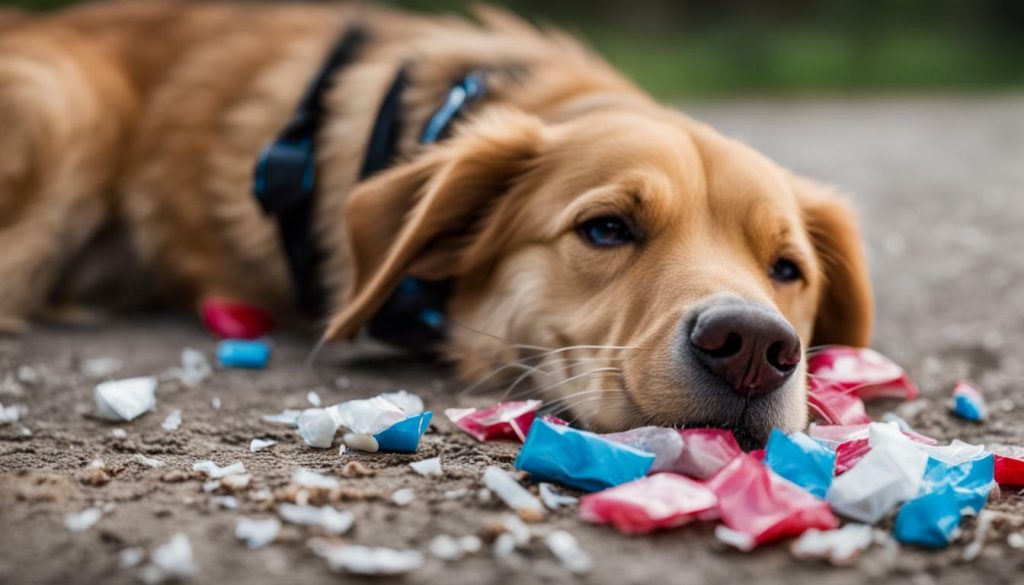
It’s important to note that not all gums contain xylitol, and some varieties are safe for dogs. However, it’s best to avoid giving your dog any type of gum as a precautionary measure. Instead, focus on providing safe alternatives that promote your dog’s dental health, such as dog-specific toothpaste and dental treats designed to reduce plaque and tartar buildup.
Immediate Actions to Take if Your Dog Eats Gum
If you suspect that your dog has ingested gum, quick action is crucial to minimize the potential harm caused by xylitol toxicity. Here are the immediate actions you should take:
- Remove any remaining gum: If you witness your dog eating gum, try to remove any remaining gum from their mouth. Be careful not to get bitten, as dogs may become defensive when you try to take something away from them.
- Contact your veterinarian: Call your veterinarian right away and provide them with all the necessary information, including the brand of gum and whether it contained xylitol. They will be able to advise you on the next steps to take and may ask you to bring your dog in for an examination.
- Monitor your dog’s behavior: Keep a close eye on your dog and watch for any signs of xylitol toxicity, such as vomiting, weakness, tremors, or seizures. Note down any changes in behavior or symptoms to share with your veterinarian.
- Do not induce vomiting: Unless specifically advised by your veterinarian, do not try to induce vomiting in your dog. In some cases, inducing vomiting can be more harmful than helpful, so always follow the guidance of a veterinary professional.
Remember, time is of the essence when it comes to xylitol toxicity. The sooner you seek veterinary care, the better the chances of successful treatment and a positive outcome for your furry friend.
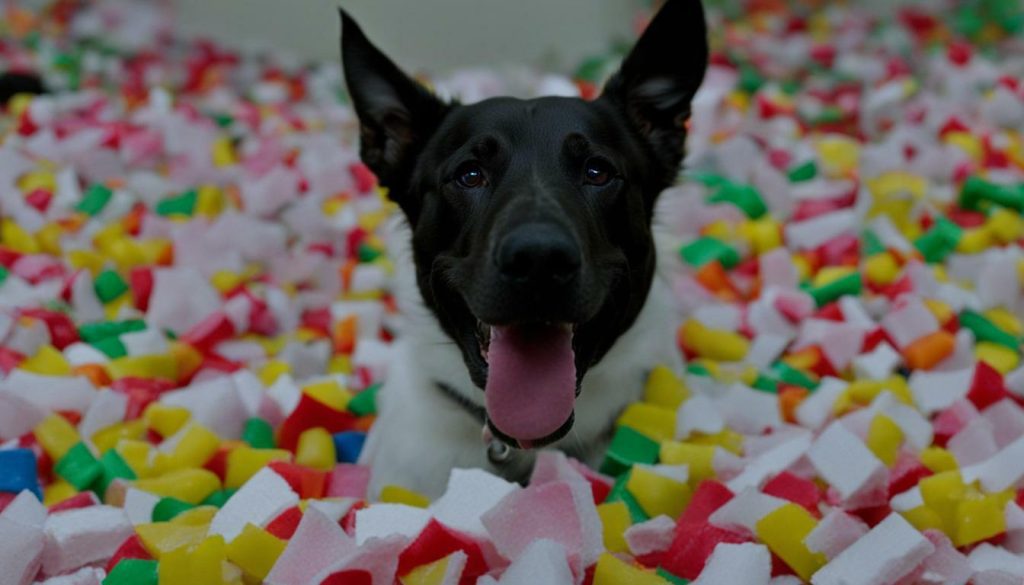
By taking these immediate actions and seeking prompt veterinary care, you can help minimize the potential dangers of dogs eating gum containing xylitol. Being proactive and aware of the risks can go a long way in keeping your canine companion safe and healthy.
| Xylitol | Toxicity Level in Dogs |
|---|---|
| Less than 0.1g/kg | No or minimal symptoms |
| 0.1g/kg – 0.5g/kg | Mild symptoms |
| 0.5g/kg – 1g/kg | Moderate symptoms |
| Above 1g/kg | Severe symptoms |
Treatment for Xylitol Toxicity in Dogs
Treating xylitol toxicity in dogs requires prompt veterinary care and supportive treatment to manage the potential complications. If your dog has ingested gum or any product containing xylitol, it is crucial to seek immediate professional help. Xylitol can cause a rapid drop in blood sugar levels, leading to hypoglycemia, which can be life-threatening for dogs.
The veterinarian will evaluate your dog’s condition and may conduct blood tests to monitor their blood sugar levels. If hypoglycemia is detected, they may administer intravenous fluids and dextrose to raise the blood sugar levels. This helps counteract the effects of xylitol and stabilize your dog’s condition.
In some cases, the veterinarian may induce vomiting or perform gastric lavage to remove any remaining xylitol from your dog’s system. They may also administer activated charcoal to prevent further absorption of the toxin. Additionally, your dog may receive liver protectants and supportive care to prevent liver damage and aid in recovery.
Remember, time is of the essence when it comes to xylitol toxicity. The sooner your dog receives veterinary attention, the better their chances of a successful recovery. Always keep an eye out for any signs of gum ingestion or xylitol toxicity and take immediate action to safeguard your furry friend’s health.
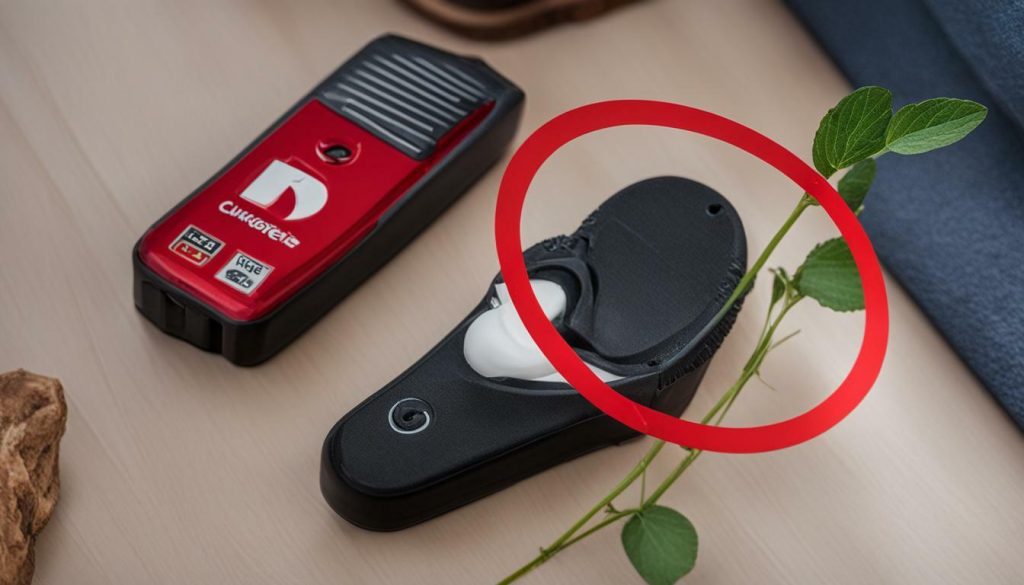
| Signs of Xylitol Toxicity in Dogs | Treatment for Xylitol Toxicity |
|---|---|
| Vomiting | Seek immediate veterinary care |
| Weakness | Monitor blood sugar levels |
| Seizures | Administer intravenous fluids and dextrose |
| Liver damage | Induce vomiting or perform gastric lavage |
| Hypoglycemia | Administer activated charcoal |
Preventing Gum Ingestion and Xylitol Toxicity in Dogs
Taking proactive measures to prevent your dog from ingesting gum and xylitol-containing products is essential for their safety and well-being. As a responsible pet owner, it’s important to create a dog-proof environment and be mindful of the potential dangers that gum can pose to your furry friend.
To keep your dog safe from gum and xylitol toxicity, consider the following steps:
- Keep all gum and xylitol-containing products securely stored out of your dog’s reach. This includes keeping purses, backpacks, and other bags containing gum or mints safely stored away.
- Be cautious when disposing of gum, ensuring it is placed in a sealed trash container that your dog cannot access.
- Regularly check your home and yard for any dropped or discarded gum, especially in areas where your dog may roam or play.
- Educate family members and visitors about the dangers of gum and xylitol to dogs, asking them to be mindful of their own gum-chewing habits and to properly dispose of gum.
- Consider using a dog-specific toothpaste and dental treats that are safe and beneficial for your dog’s oral health. These alternatives can help satisfy your dog’s chewing instincts while promoting good dental hygiene.
By implementing these preventative measures, you can significantly reduce the risk of your dog ingesting gum or other xylitol-containing products, safeguarding their health and well-being.

| Xylitol-Containing Products to Be Aware Of | Potential Symptoms of Xylitol Toxicity in Dogs |
|---|---|
| Certain dental products (toothpaste, mouthwash, etc.) | Vomiting |
| Sugar-free candies and mints | Weakness |
| Peanut butter | Seizures |
| Some medications (especially chewable ones) | Liver damage |
| Chewing gum (sugar-free and regular) | Sudden drop in blood sugar levels |
| Certain personal care items (mouthwash, nasal spray, etc.) |
Remember, prevention is key when it comes to keeping your dog safe from gum and xylitol toxicity. Taking these proactive measures and being vigilant can help ensure your dog’s health and well-being.
Dog-Specific Toothpaste and Dental Treats as Safe Alternatives
Rather than risking your dog’s health with gum, there are several safe and dog-friendly alternatives available to maintain their oral hygiene. One such alternative is dog-specific toothpaste. This specially formulated toothpaste is designed to be safe for dogs to ingest, unlike human toothpaste which can be harmful if swallowed. Dog toothpaste comes in various flavors that can appeal to your furry friend, making tooth brushing a more enjoyable experience for both of you.
In addition to toothpaste, dental treats are another great alternative to gum. Dental treats are specifically designed to promote dental health by reducing plaque and tartar buildup. They are usually made with a chewy texture that helps clean your dog’s teeth as they gnaw on them. Look for dental treats that are approved by veterinarians and specifically labeled for dental benefits, as not all treats are created equal.
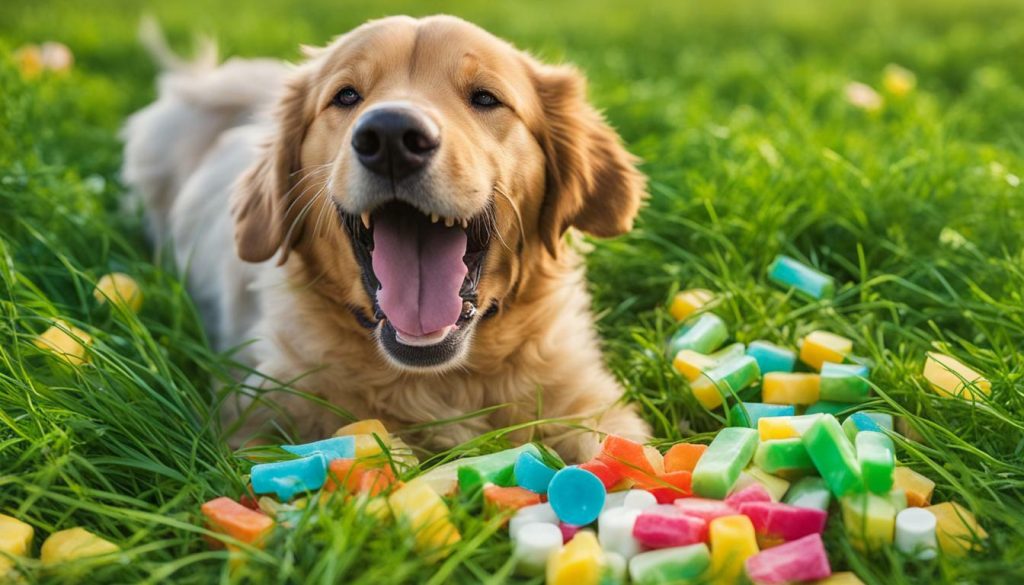
When choosing dental treats or toothpaste for your dog, it is important to consider their specific needs. Some dogs may have allergies or sensitivities to certain ingredients, so always check the labels and consult with your veterinarian if needed. Additionally, it’s crucial to follow the recommended dosage and usage instructions to ensure your dog’s safety and overall well-being.
| Dog-Specific Toothpaste | Dental Treats |
|---|---|
| Safe for dogs to ingest | Reduces plaque and tartar buildup |
| Available in various flavors | Chewy texture promotes dental health |
| Enhances the toothbrushing experience | Veterinarian-approved for dental benefits |
By incorporating dog-specific toothpaste and dental treats into your dog’s oral care routine, you can maintain their dental health without exposing them to the dangers of gum or xylitol. Remember to always prioritize your dog’s safety and consult with your veterinarian for personalized recommendations.
Other Xylitol-Containing Products to Be Aware Of
Gum is not the only product containing xylitol that can pose a threat to your dog’s health, making it crucial to be aware of other potential sources of xylitol. Xylitol can be found in a variety of products, many of which may come as a surprise.
Common Products That May Contain Xylitol:
- Sugar-free candies and mints
- Chewing gum
- Baked goods, including some cookies, cakes, and pastries
- Peanut butter and nut butter spreads
- Toothpaste and mouthwash
- Some medications, such as chewable vitamins
- Nasal sprays and nasal washes
- Personal care products, like face creams and lotions
It’s important to carefully read product labels and ingredients lists to determine if xylitol is present. Remember that even small amounts of xylitol can be dangerous to dogs, so it’s best to avoid giving them any products that contain this ingredient.
“Xylitol is highly toxic to dogs, and ingesting even a small amount can have severe consequences for their health.”
If you suspect your dog has consumed a product containing xylitol, contact your veterinarian immediately. They can provide guidance on the necessary steps to take and may recommend bringing your dog in for an examination. Remember, prompt action is vital when it comes to xylitol toxicity in dogs.
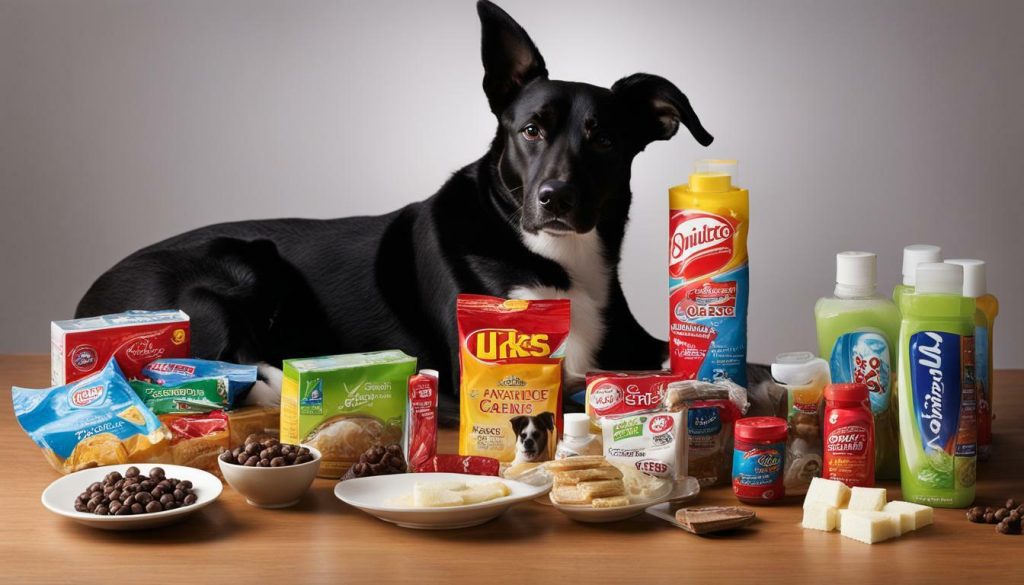
| Xylitol-Containing Product | Potential Dangers for Dogs |
|---|---|
| Sugar-free candy | Xylitol can cause a sudden drop in blood sugar levels and lead to hypoglycemia in dogs. |
| Peanut butter | Some brands of peanut butter contain xylitol, which can be toxic to dogs if ingested. |
| Toothpaste | Toothpaste containing xylitol can cause digestive upset and low blood sugar levels in dogs if swallowed. |
| Nasal sprays | Xylitol-based nasal sprays can be toxic to dogs if ingested or if they come into contact with the dog’s mucous membranes. |
Being aware of other xylitol-containing products and taking precautions to keep them out of your dog’s reach is essential for their safety and well-being. Remember, prevention is key when it comes to protecting your furry friend from xylitol toxicity.
Understanding Xylitol Toxicity in Dogs
To better understand the dangers of gum consumption and xylitol toxicity in dogs, it’s important to have a basic understanding of how xylitol affects their bodies. Xylitol is a sugar substitute that is rapidly absorbed into a dog’s bloodstream upon ingestion. While it doesn’t stimulate insulin release in humans, it has the opposite effect in dogs, causing a sudden and significant increase in insulin production.
This excessive release of insulin can lead to a rapid decrease in blood sugar levels, a condition known as hypoglycemia. Hypoglycemia can have serious consequences for dogs, and if left untreated, it can lead to seizures, coma, and even death. It’s important to note that the onset of xylitol toxicity can occur within 10-60 minutes after ingestion, making it crucial to seek veterinary care immediately if your dog has consumed gum or any xylitol-containing product.
In addition to causing hypoglycemia, xylitol can also have toxic effects on a dog’s liver. High doses of xylitol can cause liver failure, leading to jaundice, bleeding disorders, and other severe complications. The severity of the liver damage can vary depending on the amount of xylitol ingested and the individual dog’s sensitivity to the toxin.
Prevention is key when it comes to xylitol toxicity in dogs. It’s essential to keep all gum and xylitol-containing products out of reach of pets. Be mindful of other common products that may contain xylitol, such as sugar-free baked goods, certain toothpaste brands, and some medications. Always read product labels carefully to ensure they are safe for your furry friend.
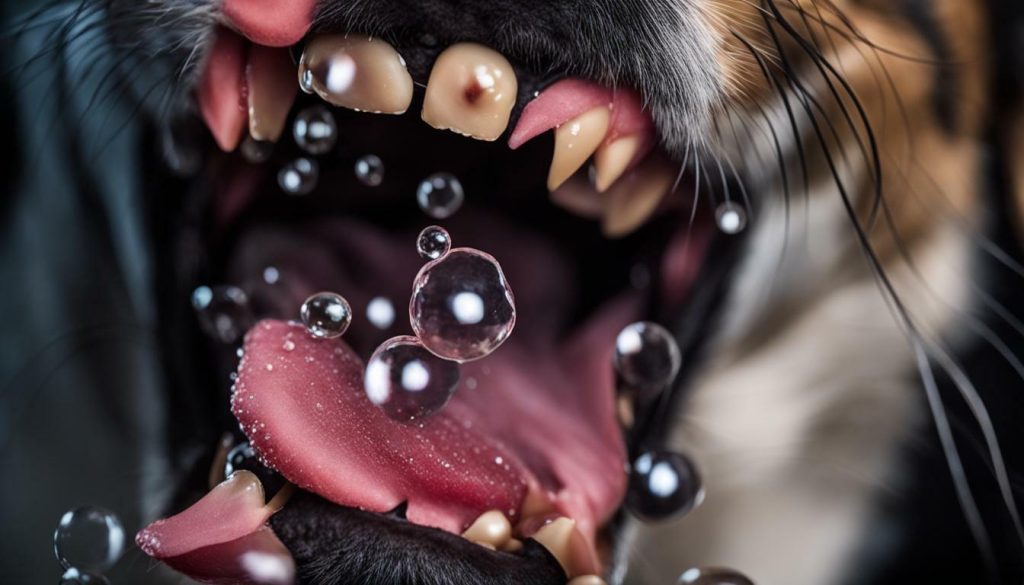
| Signs of Xylitol Toxicity in Dogs | Treatment for Xylitol Toxicity in Dogs |
|---|---|
|
|
It’s important to remember that xylitol toxicity in dogs can be life-threatening, even with small amounts of exposure. Seek immediate veterinary care if you suspect your dog has ingested gum or any product containing xylitol.
The Importance of Regular Dental Care for Dogs
Maintaining proper dental care for your dog is essential not only for their oral health but also for their overall physical well-being. Just like humans, dogs are prone to dental issues such as plaque buildup, tartar, and gum disease. Poor oral hygiene can lead to various health problems, including bad breath, tooth decay, and even infections that can spread to other parts of their body.
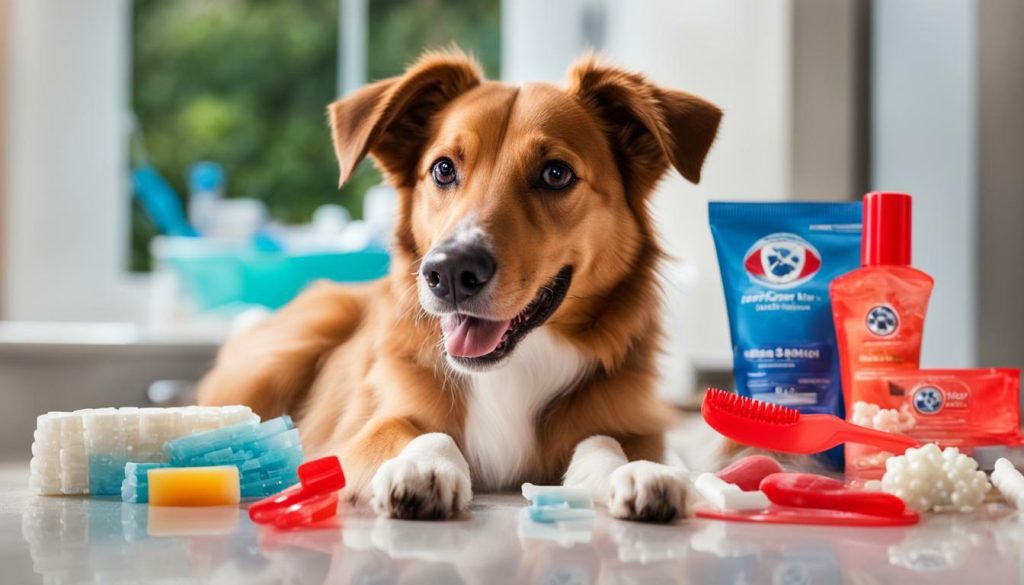
Regular dental care for dogs involves a combination of at-home care and professional veterinary dental cleanings. At home, you can start by brushing your dog’s teeth on a regular basis using a dog-specific toothbrush and toothpaste. It’s important to use toothpaste that is specifically designed for dogs, as human toothpaste can be harmful to them. Additionally, providing your dog with dental treats and toys can help promote healthy teeth and gums by reducing plaque and tartar buildup.
If your dog’s dental health requires more advanced care, it is recommended to schedule regular dental cleanings with your veterinarian. During these cleanings, your vet will thoroughly examine your dog’s teeth and gums, remove any plaque and tartar buildup, and address any dental issues such as tooth extractions or oral infections.
| Dental Care Tips for Dogs |
|---|
| 1. Brush your dog’s teeth regularly using dog-specific toothpaste and a toothbrush. |
| 2. Provide dental treats and toys to help reduce plaque and tartar buildup. |
| 3. Schedule regular dental cleanings with your veterinarian. |
| 4. Be on the lookout for signs of dental problems, such as bad breath, swollen gums, or difficulty chewing. |
| 5. Avoid giving your dog human food that can be harmful to their teeth, such as sugary or sticky treats. |
By prioritizing your dog’s dental care, you can help prevent dental issues and ensure their overall health and well-being. Remember to consult with your veterinarian for personalized advice on your dog’s specific dental needs and to address any concerns you may have.
Making Informed Choices for Your Dog’s Health
As responsible pet owners, it is crucial that we make informed choices regarding our dog’s diet and overall health, including being aware of the dangers associated with gum consumption. While chewing gum may seem harmless to us, it can be highly toxic to our furry friends, especially if it contains xylitol, a sugar substitute that can have serious consequences for dogs.
When it comes to keeping our dogs safe, prevention is key. The first step is to ensure that gum and other xylitol-containing products are kept out of reach. Dogs are notorious for getting into things they shouldn’t, so it’s essential to store these items in cabinets or drawers where your pet cannot access them. Additionally, be cautious of other products that may contain xylitol, such as certain dental products, medications, and personal care items.
“It only takes a small amount of gum containing xylitol to be potentially toxic to a dog, so it’s important to keep gum and other xylitol-containing products out of reach of pets.”
If you suspect that your dog has ingested gum or any product containing xylitol, it is crucial to seek immediate veterinary care. Xylitol toxicity can lead to a sudden drop in blood sugar levels, causing symptoms such as vomiting, weakness, seizures, and liver damage. There is no antidote for xylitol toxicity, so treatment involves monitoring the dog’s blood sugar levels and providing supportive care.
Fortunately, there are safe alternatives to gum that can promote your dog’s dental health. Dog-specific toothpaste and dental treats are designed to meet your pet’s oral hygiene needs without posing any harm. These products not only help maintain healthy teeth and gums but also provide a safe chewing outlet for your dog, satisfying their natural urge to chew.

| Benefits of Dog-Specific Toothpaste and Dental Treats |
|---|
| 1. Promotes healthy teeth and gums |
| 2. Helps prevent tartar buildup and bad breath |
| 3. Provides a safe chewing outlet for your dog |
| 4. Helps maintain fresh breath |
By making informed choices and prioritizing your dog’s health, you can ensure that they live a happy and fulfilling life. Remember to keep gum and other xylitol-containing products out of reach, seek immediate veterinary care if ingestion occurs, and provide safe alternatives like dog-specific toothpaste and dental treats to maintain your pet’s oral health. Together, we can keep our furry friends safe and healthy!
Conclusion
To ensure the well-being of our furry friends, it is imperative to understand that gum is not safe for dogs and take necessary precautions to prevent them from accessing it. Can dogs eat gum? The answer is no. Gum, especially sugar-free gum that contains xylitol, can be extremely dangerous for dogs.
Xylitol is a low-calorie sugar substitute that is toxic to dogs. It can cause a sudden drop in blood sugar levels, leading to symptoms such as vomiting, weakness, seizures, and even liver damage. It only takes a small amount of gum containing xylitol to be potentially toxic to a dog, so it’s important to keep gum and other xylitol-containing products out of reach of pets.
If a dog has ingested gum or any product containing xylitol, it is recommended to seek immediate veterinary care. There is no antidote for xylitol toxicity, so treatment involves monitoring the dog’s blood sugar levels and providing supportive care. It is also important to dog-proof the house and be cautious of other products that may contain xylitol, such as certain dental products, medications, and personal care items.
Alternatives to gum that are safe for dogs include dog-specific toothpaste and treats designed for dental health. These alternatives can still promote your dog’s dental health without posing any risk to their well-being. By being aware of the dangers of gum and xylitol to dogs, and by making the right choices for our pets, we can ensure their safety and overall health.
FAQ
Can dogs eat gum?
No, dogs should not eat gum. Gum, especially sugar-free gum that contains xylitol, can be extremely dangerous for dogs.
What is xylitol?
Xylitol is a low-calorie sugar substitute that is toxic to dogs. It can cause a sudden drop in blood sugar levels, leading to various symptoms and even liver damage.
What are the symptoms of xylitol toxicity in dogs?
Dogs who have ingested gum or other xylitol-containing products may experience symptoms such as vomiting, weakness, seizures, and changes in behavior.
What should I do if my dog eats gum?
If your dog consumes gum or any product containing xylitol, it is recommended to seek immediate veterinary care. Time is of the essence in preventing further complications.
How is xylitol toxicity in dogs treated?
Treatment for xylitol toxicity involves monitoring the dog’s blood sugar levels and providing supportive care. There is no antidote for xylitol toxicity.
How can I prevent gum ingestion and xylitol toxicity in dogs?
It’s important to dog-proof your home and keep gum and other xylitol-containing products out of reach. Be cautious of other items that may contain xylitol, such as dental products and medications.
Are there safe alternatives to gum for dogs?
Yes, there are safe alternatives to gum for dogs, such as dog-specific toothpaste and dental treats designed for dental health.
What other products may contain xylitol?
Aside from gum, other products that may contain xylitol include certain dental products, medications, and personal care items. Always read labels and be aware of potential dangers.
Why is dental care important for dogs?
Regular dental care is crucial for dogs’ overall health. Poor oral hygiene can lead to dental diseases and other health issues.
Why is it important to make informed choices for my dog’s health?
Making informed choices, such as avoiding gum and choosing safe alternatives, is essential for ensuring your dog’s well-being and preventing potential health risks.






